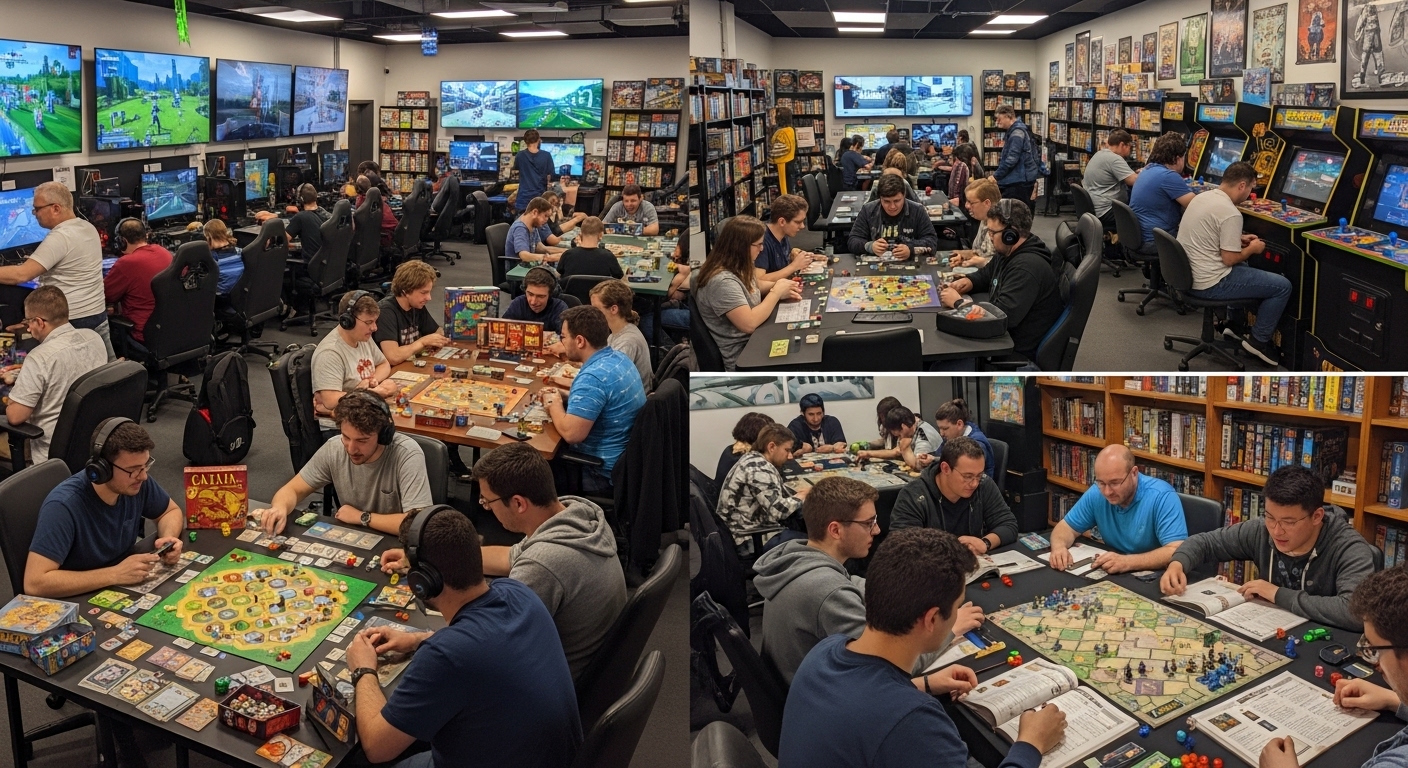Gaming has evolved from a niche hobby into one of the largest entertainment industries in the world. From its humble beginnings in arcades and home consoles to the immersive virtual worlds of today, video games have undergone a dramatic transformation. This journey has not only shaped the way we play but has also influenced culture, technology, and even the way we connect with one another. In this blog post, we will explore the fascinating evolution of gaming, examining its milestones, technological advancements, and cultural impact over the decades.
The Birth of Video Games: Early Innovations
The story of video games begins not with flashy graphics or complex storylines, but with simple, innovative concepts. The first video games were born in research labs and universities in the late 1950s and early 1960s. These early games were experiments that explored the potential of computers as interactive entertainment tools.
In 1952, British mathematician A.S. Douglas created OXO, a digital version of tic-tac-toe, for the EDSAC computer. Around the same time, American physicist William Higinbotham created Tennis for Two (1958), a rudimentary tennis game displayed on an oscilloscope. These early prototypes were mostly educational tools or demonstrations of what was possible with emerging computer technology.
The turning point for video gaming came in 1972, when Nolan Bushnell, the founder of Atari, released Pong, the first commercially successful arcade game. Pong was simple: players controlled paddles on either side of the screen and bounced a ball back and forth. Despite its simplicity, Pong became an instant success, laying the groundwork for the arcade gaming boom that would follow in the 1970s and 1980s.
The Golden Age of Arcades: 1970s and 1980s
The late 1970s and early 1980s marked the golden age of arcade gaming. Arcades became cultural hubs, filled with flashing lights, loud sounds, and eager players competing for high scores. The success of Pong spurred a flood of new arcade games, each offering unique challenges and experiences.
One of the most iconic games from this era was Space Invaders (1978), developed by Tomohiro Nishikado. Space Invaders introduced a new level of gameplay, with players defending Earth from waves of alien invaders. The game’s innovative mechanics and addictive nature led to it becoming a global phenomenon, and it is often credited with creating the “shooter” genre.
Shortly after, in 1980, Namco released Pac-Man, a game that would become an enduring symbol of the arcade era. Pac-Man was revolutionary not only because of its engaging gameplay but also because it appealed to a wider audience, including women and non-gamers. The game’s success was instrumental in establishing video games as a mainstream form of entertainment.
Other notable games from the golden age include Donkey Kong (1981), which introduced the world to Mario (then known as Jumpman), and Frogger (1981), which challenged players to guide a frog across a busy road and river. These titles, along with countless others, solidified the arcade as the dominant platform for gaming during the late 1970s and early 1980s.
The Rise of Home Consoles: 1980s and 1990s
While arcade games continued to thrive, the 1980s also saw the rise of home video game consoles. The Atari 2600, released in 1977, was the first major home console, bringing the arcade experience into people’s homes. The Atari 2600 had a significant impact on the gaming landscape, but it was not without its challenges. The video game crash of 1983, partly caused by an oversaturation of low-quality games, nearly destroyed the industry.
However, in the mid-1980s, Nintendo helped to revive the gaming market with the release of the Nintendo Entertainment System (NES) in 1985. The NES not only delivered high-quality games like Super Mario Bros., The Legend of Zelda, and Metroid, but it also introduced strict quality control measures for developers, ensuring that only high-quality games made it to market. The NES became a huge success and is often credited with saving the video game industry from its crash in the early 1980s.
The 1990s saw a fierce battle between console manufacturers, with Nintendo, Sega, and Sony all competing for dominance. Sega’s Genesis (released in 1988) became a major competitor to the NES, and the rivalry between Sega and Nintendo intensified with the release of games like Sonic the Hedgehog and Super Mario World. The competition pushed both companies to innovate, resulting in some of the most memorable games of the decade.
In 1994, Sony entered the gaming market with the PlayStation. The PlayStation was a game-changer, offering cutting-edge 3D graphics and a powerful CD-ROM format that allowed for larger, more complex games. Titles like Final Fantasy VII, Metal Gear Solid, and Gran Turismo became iconic and helped establish Sony as a dominant force in the gaming industry.
The Advent of 3D Gaming: Late 1990s to Early 2000s
The late 1990s and early 2000s marked the transition from 2D to 3D gaming. This shift was made possible by the increasing power of consoles and PCs, which allowed developers to create more complex and visually stunning worlds.
The Nintendo 64, released in 1996, was one of the first consoles to offer true 3D gameplay. It introduced groundbreaking games like Super Mario 64 and The Legend of Zelda: Ocarina of Time, both of which are considered masterpieces of game design. These games not only showcased the capabilities of 3D graphics but also set new standards for game design, storytelling, and player immersion.
In 1999, Halo: Combat Evolved was released for the Xbox, and it quickly became a landmark title in gaming history. Halo popularized first-person shooters on consoles and introduced innovative multiplayer features, paving the way for the online multiplayer experiences that would dominate the next decade.
As 3D gaming continued to evolve, the early 2000s saw the rise of open-world games. Grand Theft Auto III (2001) revolutionized the gaming landscape with its vast, open city environments and freedom of choice. This style of gameplay was later refined by games like The Elder Scrolls V: Skyrim (2011) and Red Dead Redemption 2 (2018), which offered players immersive worlds filled with hundreds of hours of content.
The Age of Online Multiplayer and eSports: 2000s and 2010s
The 2000s and 2010s saw the rise of online multiplayer gaming, which revolutionized how people played and interacted with video games. The launch of Xbox Live in 2002 and the introduction of broadband internet made it easier than ever for players to connect with each other across the globe. Games like Halo 2, World of Warcraft, and Call of Duty 4: Modern Warfare became the focal points of a new era of online competition and collaboration.
World of Warcraft (2004) became a cultural phenomenon, attracting millions of players and setting the stage for the explosion of massively multiplayer online role-playing games (MMORPGs). In WoW, players could explore a vast world, complete quests, and interact with thousands of other players in real-time. The game’s success paved the way for the growth of online gaming communities, guilds, and social networks within games.
The 2010s saw the rise of eSports, where competitive gaming became a professional sport with huge tournaments and massive prize pools. Games like League of Legends, Dota 2, and Counter-Strike: Global Offensive became staples of the eSports scene, attracting millions of viewers and even inspiring traditional sports organizations to invest in gaming.
Streaming platforms like Twitch allowed gamers to broadcast their gameplay to global audiences, further elevating gaming to the level of a spectator sport. The rise of eSports and streaming transformed gaming into a global industry, with millions of people watching, playing, and competing in games on a daily basis.
The Modern Gaming Landscape: Virtual Reality and the Future
As we enter the 2020s, the gaming landscape is evolving faster than ever before. Virtual reality (VR) and augmented reality (AR) have become prominent features in the gaming world. VR systems like the Oculus Quest and PlayStation VR allow players to immerse themselves in fully realized 3D environments, offering an unprecedented level of interaction and presence in virtual worlds.
The development of cloud gaming services, such as Xbox Cloud Gaming and Google Stadia, is changing the way people access and play games. These services allow players to stream games to their devices without the need for expensive hardware, democratizing access to high-quality gaming experiences. Cloud gaming also enables cross-platform play, allowing friends to play together regardless of their chosen devices.
In addition to technological advancements, gaming continues to diversify in terms of both content and audience. More and more games feature diverse characters, stories, and settings that reflect a broader range of experiences. Games like The Last of Us Part II, Horizon Zero Dawn, and Overwatch have received praise for their representation of different genders, ethnicities, and sexual orientations. This shift towards inclusivity has made gaming more accessible and welcoming to players from all walks of life.
Conclusion: Gaming’s Ever-Expanding Horizon
The evolution of video games is a story of technological innovation, cultural transformation, and the relentless pursuit of immersive experiences. From the early days of Pong and Space Invaders to the virtual realities of today, gaming has transformed into a global phenomenon that touches nearly every aspect of modern life.
As technology continues to advance, the future of gaming looks brighter than ever. With the continued development of VR, AR, cloud gaming, and AI, the possibilities for what video games can offer seem limitless. One thing is certain: the world of gaming will continue to grow, innovate, and inspire for years to come.
Whether you’re a casual player, a competitive eSports enthusiast, or a developer pushing the boundaries of what’s possible, the journey of gaming is far from over.




